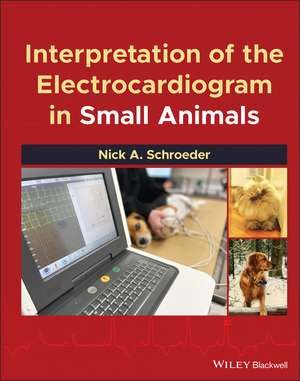Interpretation of the Electrocardiogram in Small Animals
Autor NA Schroederen Limba Engleză Hardback – 27 iun 2021
Interpretation of the Electrocardiogram in Small Animals delivers a simplified and accessible approach to electrocardiography interpretation for veterinarians treating dogs and cats. This practical manual covers a comprehensive list of arrhythmias and associated phenomena using an easy-to-follow format, with hundreds of electrocardiograms and ladder diagrams supporting the text.
The book focuses on the clinical applications of electrocardiographic interpretation, with less emphasis on physics and subcellular mechanisms, making the book a useful patient-side resource. Interpretation of the Electrocardiogram in Small Animals offers readers an up-to-date understanding and knowledge of common and rare phenomena alike.
Beginning with a description of the single cardiac cycle as illustrated by surface EKG, the book moves on to describe variations on the P-QRS-T complex that occur in response to chamber enlargement and hypertrophy. Readers will also benefit from the inclusion of:
- A detailed discussion of aberrancy and its differentiation from ventricular ectopy
- A thorough exploration of arrhythmias and conduction disorders including escape mechanisms, atrioventricular block, extrasystoles, accelerated rhythms, tachycardias, flutter and fibrillation
- An examination of pacemaker basics, as well as a few common abnormalities and pacemaker problems, including undersensing, oversensing, and failure to capture
Preț: 749.06 lei
Preț vechi: 1073.00 lei
-30% Nou
143.38€ • 155.79$ • 120.52£
Carte indisponibilă temporar
Specificații
ISBN-10: 1119763053
Pagini: 400
Dimensiuni: 211 x 295 x 25 mm
Greutate: 1.27 kg
Editura: Wiley
Locul publicării:Hoboken, United States
Descriere
Interpretation of the Electrocardiogram in Small Animals delivers a simplified and accessible approach to electrocardiography interpretation for veterinarians treating dogs and cats. This practical manual covers a comprehensive list of arrhythmias and associated phenomena using an easy-to-follow format, with hundreds of electrocardiograms and ladder diagrams supporting the text. The book focuses on the clinical applications of electrocardiographic interpretation, with less emphasis on physics and subcellular mechanisms, making the book a useful patient-side resource.
Interpretation of the Electrocardiogram in Small Animals offers readers an up-to-date understanding and knowledge of common and rare phenomena alike. Beginning with a description of the single cardiac cycle as illustrated by surface EKG, the book moves on to describe variations on the P-QRS-T complex that occur in response to chamber enlargement and hypertrophy. Readers will also benefit from the inclusion of: A detailed discussion of aberrancy and its differentiation from ventricular ectopyA thorough exploration of arrhythmias and conduction disorders including escape mechanisms, atrioventricular block, extrasystoles, accelerated rhythms, tachycardias, flutter and fibrillationAn examination of pacemaker basics, as well as a few common abnormalities and pacemaker problems, including undersensing, oversensing, and failure to captureInterpretation of the Electrocardiogram in Small Animals is a convenient, one-stop reference for the interpretation of electrocardiography in small animals for veterinary students, residents, and specialists as well as for small animal general practitioners
